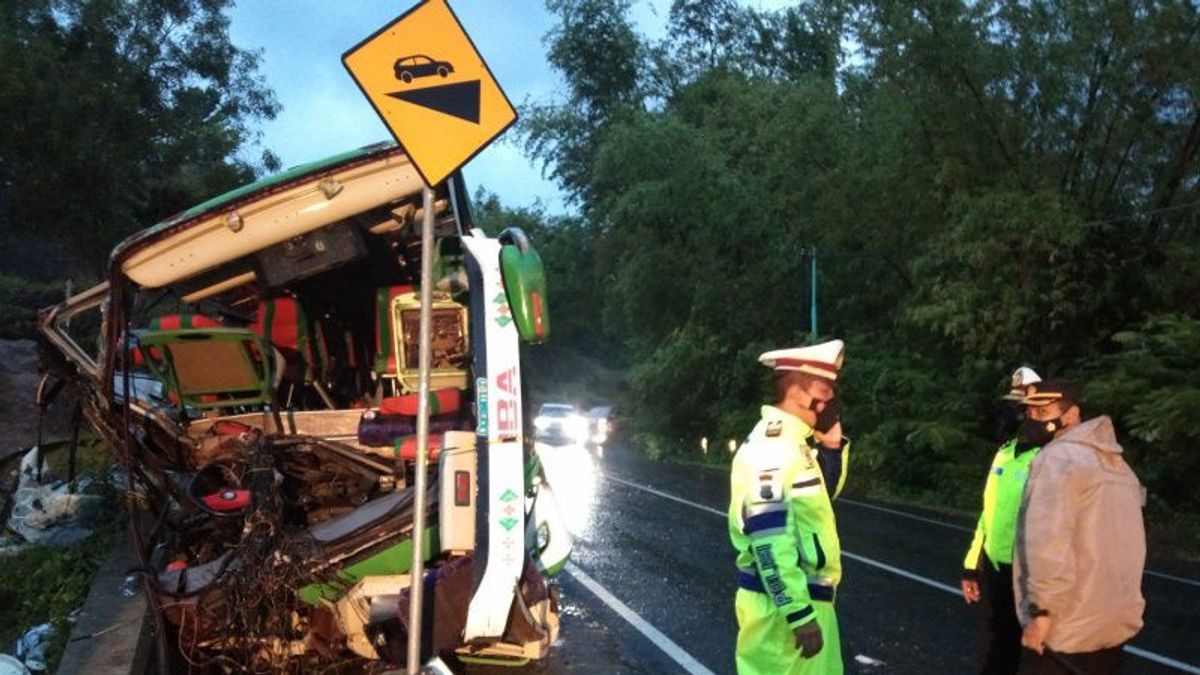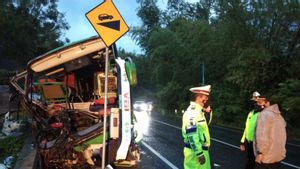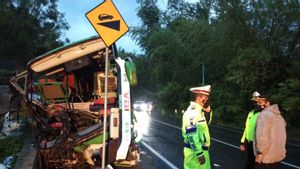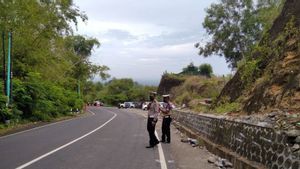JAKARTA - The tourism bus accident in the Imogiri area, Bantul, Yogyakarta Special Region on Sunday, February 6, 2022, which claimed the lives of 13 people and injured 47 others, is truly saddening. The tragedy reminds us that the safety factor on the highway is still often neglected.
A tourism bus carrying a group of garment factory employees from Sukoharjo, Central Java for a picnic to Imogiri, had a single accident. It is suspected that the brakes failed while crossing the Imogiri-Dlingo road, the bus hit a cliff and stopped in a crushed condition on the right.
A total of 13 passengers were reported killed and the remaining 47 people with minor and serious injuries. The dead were taken back to Sukoharjo, while the injured passengers were being treated at several hospitals in Bantul and its surroundings.

In the last two years, according to VOI records, there were at least nine bus accidents that claimed a total of 119 lives. Here is a list of those bus accidents:
- The Rosalia Indah bus collided with a truck in Way Kanan Regency, Lampung on September 16, 2019, which claimed the lives of 8 people.
- The PMTOH bus crashed in Kuantan Singingi, Riau on October 9, 2019, the death toll was 6 people.
- The Sinar Jaya bus collided with the Arimbi bus on the Cipali Km 117.8 toll road on November 14, 2019, the death toll was 7 people.
- A tourism bus overturned into a river in Blitar Regency, East Java on December 7, 2019, 5 people died.
- The Sriwijaya bus fell into a ravine in Pagar Alam, South Sumatra on December 23, 2019, and claimed 35 lives.
- The Purnamasari bus fell into a ravine in Subang, West Java on January 18, 2020, killing 8 people.
- The Sri Padma Kencana bus rolled into a ravine in Tanjakan Cae, Sumedang, West Java on March 10, 2021, killing 29 people.
- The Sudiro Tunggal Daya bus collided with a truck on the Pemalang toll road, Central Java Km 308, resulting in the loss of 8 passengers' lives.
- The GA Trans tourism bus crashed into the Bukit Bego cliff in Imogiri, Bantul, Yogyakarta Special Region on February 6, 2022, and resulted in 13 deaths.
The rules keep changing, the results are the same
The regulations regarding the safety of land transportation have either been changed or refined several times. Finally, there is Government Regulation No. 37 of 2017 concerning Traffic and Road Transportation Safety. But why do fatal accidents that claim so many lives still happen?
Notes from the Yogyakarta Special Region Police, throughout 2021 there were 5350 accident cases with 452 fatalities. This number increased compared to the case in 2020, which recorded 4559 accidents with 346 deaths.

According to the Director-General of Land Transportation of the Ministry of Transportation, Budi Setyadi, there are five basic problems surrounding land transportation in Indonesia, including buses. The first is efficiency and effectiveness because land transportation has not been well integrated.
Second, Budi refers to the driver's egoism. The third is the neglect of safety aspects, thus causing traffic accidents. Based on the records of the World Health Organization (WHO) in 2019, Indonesia was ranked 8th out of 11 countries in Southeast Asia in terms of the death rate due to traffic accidents. The record shows a figure of 12.2 percent of every 100,000 population.
Fourth, mass transportation is not evenly distributed, because Indonesia is geographically an archipelagic country. Fifth, the interest in the use of private vehicles is still far greater than public land transportation. This is due to the poor integration of land transportation.
Improved Transportation Safety
According to the Chairman of the National Transportation Safety Committee (KNKT), Soerjanto Tjahjono, Indonesia has actually started cooperation with Australia to improve the safety of land transportation.
"Research results on safety issues, for example regarding safety signs. Traffic signs must not cause any harm, for example, being accidentally hit by a vehicle that hits it is the one that is injured," said Soerjanto, as quoted by Antara.
The NTSC noted that most cases of ground transportation accidents were caused by fatigued drivers. Vehicle feasibility tests must also be carried out regularly with strict supervision from the relevant authorities. In addition, KNKT also asks consumers to participate in monitoring by choosing vehicles that are suitable for operation.

The application of technology for bus safety such as Antilock Brake System (ABS), Electronic Brake System (EBS), Electronic Stability Control (ESC), Adaptive Cruise Control (ACC), Lane Departure Warning System (LDWS), to radar for turning safety has actually been provided. in modern buses. All these sophisticated devices will be useless if the vehicle is cared for arbitrarily and the driver is not in top condition or reckless.
Without self-awareness to prioritize safety, news of bus accidents may still often decorate the pages of the media in Indonesia. Hopefully, that doesn't happen.
SEE ALSO:
The English, Chinese, Japanese, Arabic, and French versions are automatically generated by the AI. So there may still be inaccuracies in translating, please always see Indonesian as our main language. (system supported by DigitalSiber.id)














